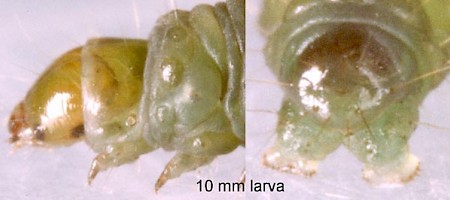49.183 BF1108
Lobesia abscisana
(Doubleday, [1849])
Wingspan 10-13 mm.
A smallish moth, and darker than related species, it is locally distributed mainly in the south and south-east of England, with some records from further north into Yorkshire.
The adults fly in May and again in July and August. Flying from dusk onwards, they are attracted later to light.
The larvae feed in spinnings on the shoots of creeping thistle (Cirsium arvense).
Larva: (description Ian F. Smith)
See also Cirsium key.
Foodplant: June and Aug.- Sept. in spun shoots of Cirsium arvense, eating down into stem.
Length: 10 mm described
Head: Translucent shining greenish brown. Mouthparts darker brown. Along posterior edge of capsule, a thin black line terminating in a pitchy black postero-lateral mark. Stemmatal area black.
Prothoracic shield: Concolorous with, but slightly paler than, abdomen. Shiny, transparent showing head below.
Thoracic legs: Coxa concolorous, has flattened black 'v' line at anterior of base. Femur and tibia yellowish-green. Tarsus brownish.
Body: Shiny translucent jade-like bluish green. Darkened dorsally by indistinct viscera. Faintly shagreened. Occasionally an olive-brown form is found.
Spiracles: Small. Brown peritreme.
Pinacula: Unobtrusive, concolorous, not shagreened, shiny.
Setae: Transparent colourless, or pale brown in some light.
Anal plate: Concolorous. Darkened if frass in anal segment.
Prolegs: Concolorous translucent. Reddish brown crochets.
Comments: Can be difficult to rear. Try on potted young C. arvense plant.

 UKMoths
UKMoths 




